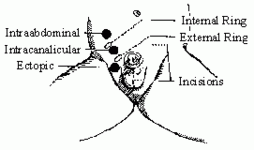Testicles are the ball-like structures located in the scrotum. They produce sperm and testosterone, the male sex hormone.
The testes develop in the abdomen and move down into the scrotum shortly before birth. In about 1% of all full-term boy babies, one or both of the testicles do not move all the way down into the scrotum. This condition is even more common in babies born too early or who don't weigh enough. In some babies, the testicle may move down on its own during the first six months of life.
When it remains undescended, the testicle may be found anywhere in a path from the abdomen to the upper part of the scrotum, or even outside the scrotum (ectopic testis). When the testis fails to reach the scrotum, the passage through which it travels remains open (patent processus vaginalis) and provides a place for hernias to occur. If the testicle is not in the scrotum by six months of age, surgery will probably be needed to bring it down into a normal position, and to correct the potential hernia site. This surgery is usually recommended around 6 months of age.
Some testicles are "retractile" and will move in and out of the scrotum. The testicles tend to come down into the scrotum when the child is in a warm bath, but may later move up out of the scrotum. As the testicle grows, it tends to stay in the scrotum. In general, surgery is not needed for the retractile testicle.
Reasons for surgery
There are several reasons to move the testicle into the scrotum.
- Normal appearance.
- Testicles need a lower temperature to develop normally and produce sperm. By doing surgery at a young age, we hope that the testicle will make a normal number of functioning sperm.
- Males with undescended or maldescended testicles have more cancer of the testicle. This form of cancer is very treatable if detected early. It is important that the testicle be brought into the scrotum so that it can be examined at yearly checkups, and on self-examination. Moving the testis to the scrotum does not decrease the risk of cancer, but it allows examination for early detection of any concerns.
- Close the potential hernia site associated with failure of the testis to descend.
Surgical procedure
The procedure for moving the testicle into the scrotum is called orchidopexy, often combined with an inguinal hernia repair. This surgery is generally done as an outpatient procedure. In most cases, two incisions are made, one in the groin and one in the scrotum. During the surgery the blood vessels attached to the testicles are freed up so the testicle can be moved into the scrotum. If a hernia is associated with the undescended or maldescended testicle, it is repaired at this time. There is a 90% success rate with this procedure.
If the testes are in the abdomen (not able to be felt on examination under anesthesia), laparoscopy and possibly a two-stage procedure may be necessary in rare instances.
Potential risks and complications of the procedure include injury to the testicle, the sperm duct (vas deferens), or to the blood vessels of the testicle. Scar tissue may also form that pulls the testicle back up into the groin. Occasionally a skin infection occurs. If laparoscopy is performed, it has the added risk of injury to any other structures in the abdomen.
Follow-up
It is important that all males, especially those with a history of undescended or maldescended testicles, perform self testicular exams beginning with adolescence.
Page reviewed on: Apr 29, 2009
Page reviewed by: Leslie T. McQuiston, MD
